Lab 06.1: Create Power Automate flows
In this lab, you will create Power Automate cloud flows to automate various parts of the Company 311 solution.
The following have been identified as requirements you must implement to complete the project:
-
Escalation, approval, and execution process for urgent maintenance issues
-
Notify reporting user about the issue status changes
What you will learn
-
How to design data columns (in the data model) to support automation
-
How to build a flow using Microsoft Dataverse Connector
-
How to use approvals
High-level lab steps
- Add columns to support escalation
- Build flow to approve escalation
- Build flow to notify user of status change
- Build approval as an adaptive card in Microsoft Teams
Prerequisites
Must have completed the following labs:
-
02.1: Data model
-
02.2: Work with forms and views
-
02.3: Compose a model-driven app
-
02.4: Import data
-
02.5: Business process flows and business rules
Things to consider before you begin
- What is the most efficient way to identify urgent maintenance issues and escalate them?
Detailed steps
Exercise 1: Build notification flow
In this exercise, you create a flow that will notify the creator of a problem when the status changes.
Task 1: Create flow
In this task, you will create a flow that send a notification when the status of problem report row changes.
-
Navigate to the Power Apps maker portal and make sure you are in the correct environment.
-
Select Solutions and open the Company 311 solution.
-
Select + New > Automation > Cloud Flow > Automated.
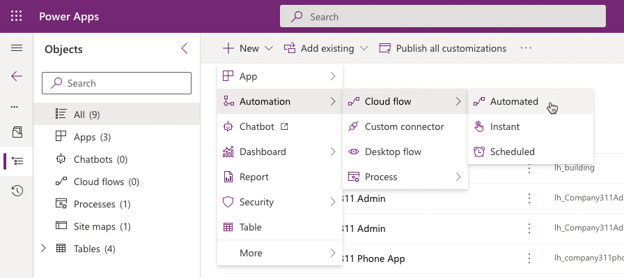
-
Search for and select the When a row is added, modified or deleted action from the Microsoft Dataverse connector.
-
Select Create.
-
Select Modified for Change type, select Problem Reports for Table name, Organization for Scope and expand Show advanced options.
-
Enter
statuscodefor Select columns then select … Menu button of the trigger step.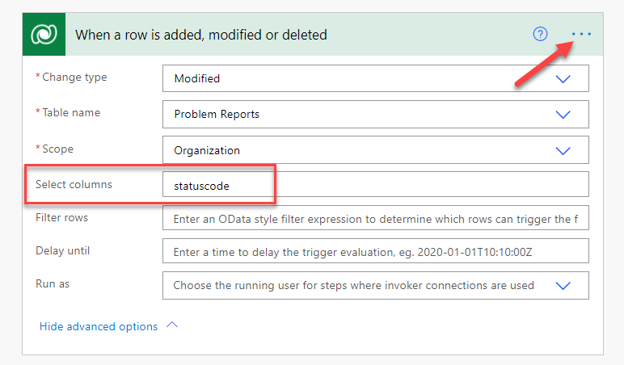
-
Select Rename.
-
Rename the trigger step
When problem report status changes -
Select + New step.
-
On the All tab, select Microsoft Dataverse then select the Get a row by ID action.
-
Select Users for Table name.
-
Select the Row ID field, go to the Dynamic content pane, search for
createdand select Created By (Value). -
Select Show advanced options on the new step.
-
Enter
internalemailaddressfor Select columns. -
Select the … Menu button of the new step and select Rename.
-
Rename the step
Get problem creator -
Select + New step.
-
Search for
send emailand select the Send an email (V2) action from the Office 365 Outlook connector. -
Select the To field and select the Switch to Advanced Mode arrows icon. Selecting this button toggles show/hide of the Dynamic content pane.

-
Select the Primary Email field from the Get problem creator step.
-
Enter
Problem report status change notificationfor Subject. -
Select the Body field.
-
Enter
The status of the problem you reported has changed.and press the [ENTER] key. -
Enter
Problem Title:, go to the Dynamic content pane, search fortitleand select Title. -
Press the [ENTER] key.
-
Enter
Current Status:, go to the Dynamic content pane, select the Expression tab, paste the expression below, and select OK. This expression will show the label of the Status Reason instead of the value.triggerOutputs()?['body/_statuscode_label']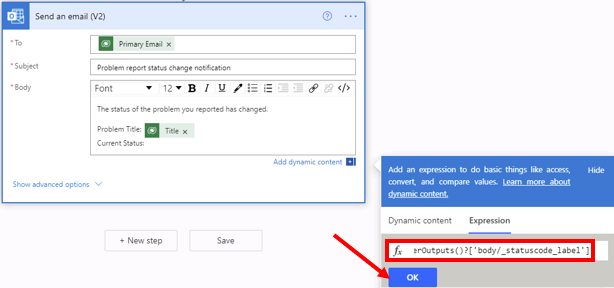
-
Select the … Menu button of the new step and select Rename.
-
Rename the step to
Notify problem creator -
The step should now look like the image below.
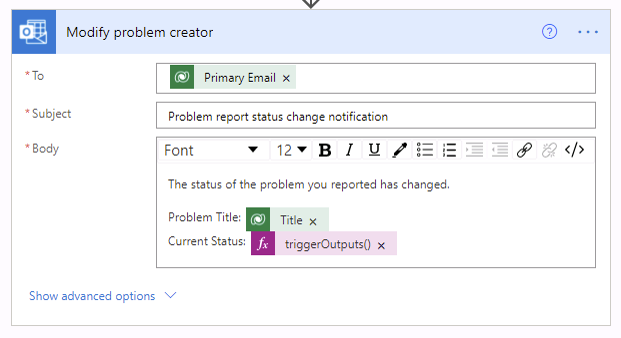
-
At the top of the page, change the flow name from Untitled to
Notify Problem Creator -
Select Save and wait for the flow to be saved.
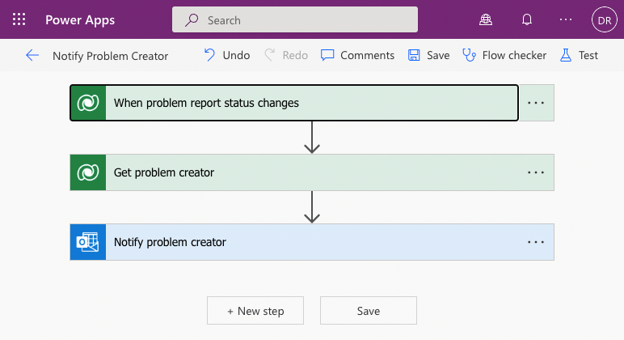
-
Select the 🡠 button to go back to the previous page.
Task 2: Test the flow
In this task, you will test the Notify Problem Creator flow.
-
On the Power Apps maker portal,
https://make.powerapps.comensure you are in the correct environment. -
Select Apps, and then select the Company 311 Admin Model-driven application. Select Play.
-
Select + New.
-
Enter
Flow testfor Title, select London Paddington for Building, enterThis is a flow testfor Details, and select Save. -
Scroll down and change the Status Reason value to In Progress and save again.
-
Close the application browser window or tab.
-
You should now be back to the Power Apps maker portal
-
Select Solutions and open the Company 311 solution.
-
Locate and open the Notify Problem Creator Cloud Flow Details in a new tab.
-
You should see a succeeded flow run in the 28-day run history section. Open the run.

-
All the flow steps should have a green check mark.
-
Select the App launcher and under Apps, select Outlook.
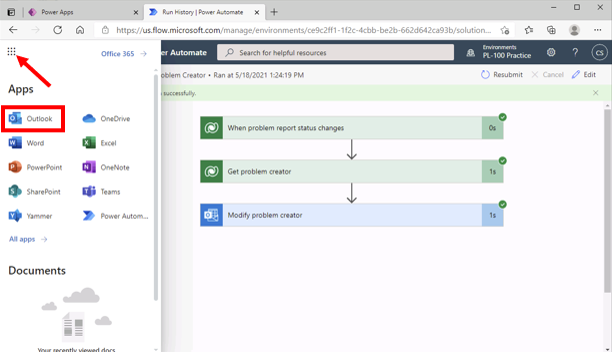
-
You should have received an email from the cloud flow. Open the email.
-
The email should resemble the image below.
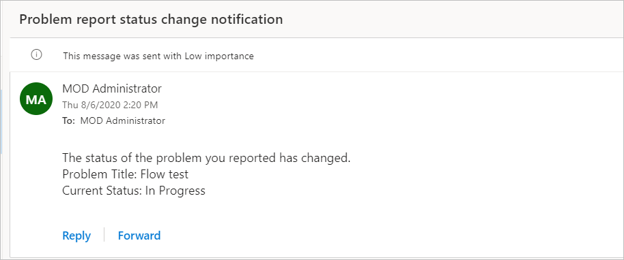
Exercise 2: Build escalation flow
In this exercise, you will create an escalation flow.
Task 2: Build escalation flow
In this task, you will create the escalation flow.
-
Navigate to the Power Apps maker portal and make sure you are in the correct environment.
-
Select Solutions and open the Company 311 solution.
-
Select + New > Automation > Cloud Flow > Automated.
-
Search for
when a row is addedand select When a row is added, modified, or deleted from the Microsoft Dataverse connector, then select Create. -
Select Added or Modified for Change type, select Problem Reports for Table name, select Organization for Scope and select Show advanced options.
-
Enter lh_estimatedcost,lh_assignto for Select columns.
-
Select the … Menu button of the trigger step and select Rename.
-
Rename the trigger step When a problem report is created or updated.
-
Select + New step.
-
Search for
Conditionand select the Condition action from the Control connector. -
Select the first Choose a value field.
-
Go to the Dynamic content pane, search for and select Estimated Cost.
-
Select is greater than in the second field and enter
1000in the third field. -
Rename the condition step to
Check if cost is greater than 1000 -
Go to the If yes branch and select Add an action.
-
Search for
Get a rowand select the Get a row by ID action from the Microsoft Dataverse connector. -
Select Users for Table name.
-
Select the Row ID field and select Assign to (Value) from the Dynamic content pane.
-
Select Show advanced options.
-
Enter
internalemailaddressfor Select columns. -
Rename the Get a Row by ID step
Get user. -
Select Add an action.
-
Search for
approvaland select the Start and wait for an approval action from the Approvals connector. -
Select Approve/Reject - Everyone must approve for Approval type.
-
Enter
Cost approval requiredfor Title. -
Select the Assigned to field.
-
Go to the Dynamic content pane and select Primary Email from the Get user step.
-
Enter the markdown text below in the Details field.
`## URGENT Approval Required
This is **very** expensive item with the estimated cost of `
-
Place your cursor after cost of, go to the Dynamic content pane, select the Expression tab, paste the expression below, and select OK.
formatNumber(triggerOutputs()?['body/lh_estimatedcost'], 'C2')
-
Select Add an action.
-
Search for and select the Condition action from the Control connector.
-
Select the first Choose a value field.
-
Go to the Dynamic content pane, search for and select Outcome.
-
Enter Reject for value in the third field.
-
Go to the If yes branch and select Add an action.
-
Search for and select the Update a row action from the Microsoft Dataverse connector.
-
Select Problem Reports for Table name.
-
Select the Row ID field.
-
Go to the Dynamic content pane, search for
problem reportand select Problem Report. -
Select Show advanced options.
-
Select the Resolution field, go to the Dynamic content pane and select Response summary.
-
Select Won’t fix for Status Reason.
-
Rename the step
Update problem report -
Scroll up and rename the flow
Escalate Expense Approval -
Select Save.
-
Close the flow designer browser window or tab.
-
Select Done on the popup.
Task 3: Test flow
In this task, you will test the escalation flow.
-
Navigate to the Power Apps maker portal and make sure you are in the correct environment.
-
Select Apps, and then select the Company 311 Admin Model-driven application. Select Play.
-
Open one of the Problem Report rows.
-
Scroll down, enter
2500for Estimated Cost, assign it to yourself (for test purposes) and select Save. -
Navigate to the Power Automate maker portal:
https://make.powerautomate.com/ -
Select Approvals.
-
You should see at least one approval in the received tab. Open the approval.
Note: It can take around 10-15 minutes for approvals to show up here on the first run as the Approvals app must provision itself in your environment.
-
Choose the Reject response, enter
We don't have the funds for this itemfor Add a comment, and select Confirm. -
Go back to the Company 311 Admin Model-driven application.
-
Change the view to My Reports and open the test row on which the Estimated Cost was changed.
-
The Status Reason should be set to Won’t fix and the Resolution should contain the details of Approver, Response, Request Date and Response Date.
Exercise 3: Send approval requests as adaptive card in Microsoft Teams
In this exercise, you will setup a team in Microsoft Teams dedicated to the Company 311 applications. You will modify the flow to send the approval request as an adaptive card in Teams chat instead of an approval message.
- Task 1: Setup Company 311 Team
- Task 2: Modify flow to send adaptive card in Teams chat
- Task 3: Test adaptive card
Task 1: Setup Company 311 Team
In this task you will setup a Microsoft Teams team for the Lamna Healthcare Company, if you have not done so in previous exercises.
-
Navigate to Microsoft Teams and sign in with the same credentials you have been using previously.
-
Select Use the web app instead on the welcome screen.
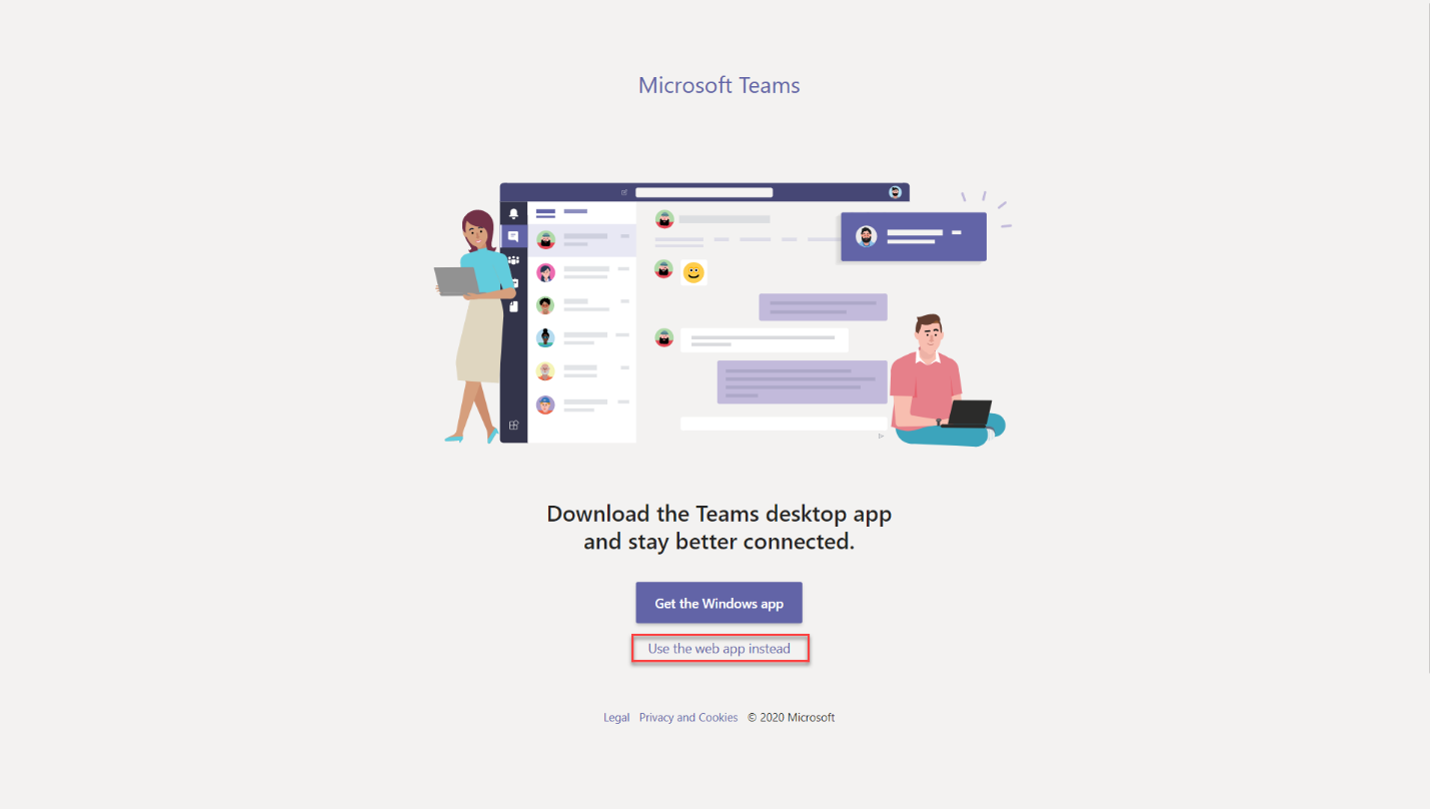
-
When the Microsoft Teams window opens, dismiss the welcome messages.
-
On the bottom left corner, choose Join or create a team.
-
Select Create a team.
-
Press From scratch.
-
Select Public.
-
For the Team name choose Company 311 and select Create.
-
Select Skip adding members to Company 311.
Task 2: Modify flow to send adaptive card in Teams chat
In this task you will replace the approval sent by email with an adaptive card.
-
Navigate to the Power Automate maker portal and make sure you are in the correct environment.
-
Select Solutions and open the Company 311 solution.
-
Select Cloud flows from the Objects pane and open the Escalate Expense Approval flow. Select Edit.
-
Locate Start and wait for an approval step created earlier in Exercise 2.
-
Select the … menu, and then select Delete.
-
Hover your mouse between the steps, select the + to insert a new step then select Add an action.
-
Search for and select Create an approval.
-
Select Approve/Reject - Everyone must approve for Approval type.
-
Enter Cost approval required for Title.
-
Select the Assigned to field.
-
Go to the Dynamic content pane and select Primary Email from the Get user step.
-
Paste the markdown text below in the Details field.
**{title}**
{details}
This is a _very_ expensive item with the estimated cost of
-
Select {title} placeholder, go to the Dynamic content pane, locate and select Title field from When a problem report is created or updated step.
-
Select {details} placeholder, go to the Dynamic content pane, locate and select Details field from When a problem report is created or updated step.
-
Place the cursor after cost of, go to the Dynamic content pane, select the Expression tab, paste the expression below, and select OK.
-
Your step should look like the following:
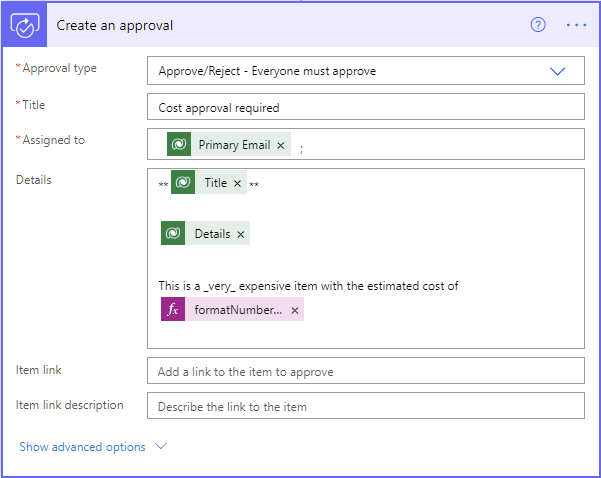
-
Hover your mouse again below Create an approval step, select + and then select Add an action.
-
Search for
teamsand select Post card in a chat or channel action. -
Select Flow bot for Post as and select Chat with Flow bot for Post in.
-
Select the Recipient field.
-
Go to the Dynamic content pane and select Primary Email from the Get user step.
-
Select Message field.
-
Go to the Dynamic content pane and select Teams Adaptive Card from the Create an approval step.
-
The Post card in a chat or channel step should look like the image below:
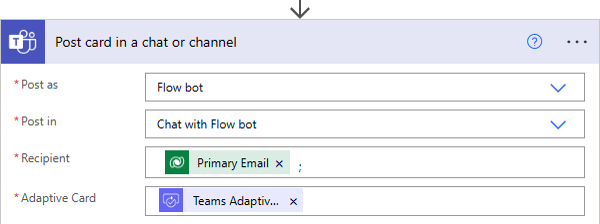
-
Hover the cursor below the Post card in a chat or channel step, select + and then select Add an action.
-
Search for
approvaland select Wait for an approval action. -
Select Approval ID field.
-
Go to the Dynamic content pane and select Approval ID from the Create an approval step.
-
You now have replaced Start and wait for an approval step with the following:
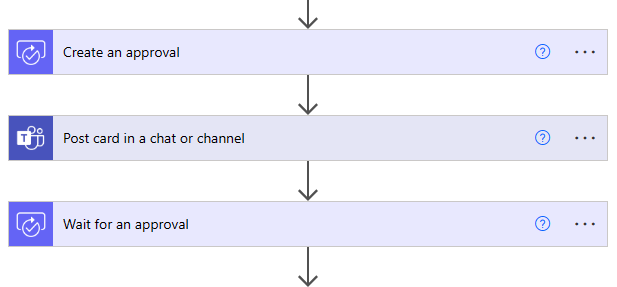
-
Expand the Condition step. The left value of the Condition step should be empty because it was referring to the old step which is now removed.
-
Go to the Dynamic content pane, search for and select Outcome from Wait for an approval step.
-
Locate the Update problem report step, under the If yes branch.
-
Select Show advanced options.
-
Select the Resolution field, go to the Dynamic content pane, and select Response summary from Wait for an approval step.
-
Select Save.
-
Close the flow designer browser window or tab.
-
Select Done on the pop-up.
Task 3: Test flow
In this task, you will test the escalation flow with the Teams and adaptive cards.
-
Navigate to the Power Apps maker portal and make sure you are in the correct environment.
-
Select Apps, and then select the Company 311 Admin Model-driven application. Select Play.
-
Open one of the Problem Report Rows.
-
Scroll down, enter any amount greater than 1000 for Estimated Cost, assign it to yourself (for test purposes) and select Save.
-
Navigate to Microsoft Teams.
-
Select Chat.
-
You should see the Cost approval required adaptive card in a message from Workflows.
-
Select the Reject button and enter a comment of your choice in the Comments area, for example The item is too expensive.
-
Select Submit. The card will become read-only.
-
Go back to the Company 311 Admin application.
-
Change the view to My Reports and open the same row you changed the estimated cost for.
-
The Status Reason should be set to Won’t fix and the Resolution should contain the details of Approver, Response, Request Date and Response Date.